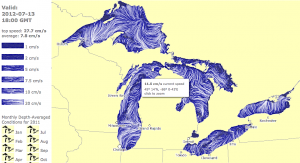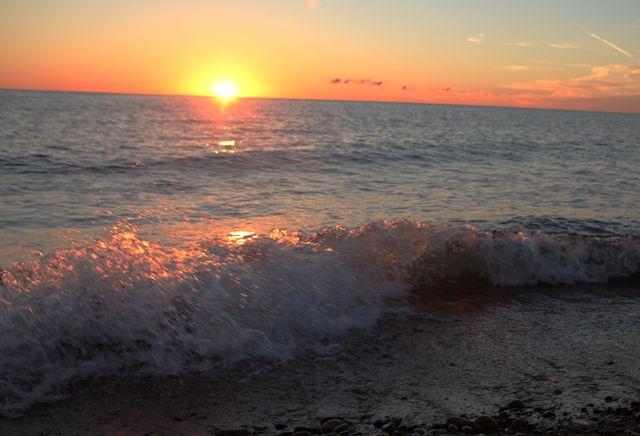
A screenshot of the surface current map from the National Oceanic and Atmospheric Administration. Photo: NOAA.gov.
An animated map of Great Lakes currents can help lake-goers interpret the speed and direction of currents in any location.
“We are trying to provide information so people can learn about circulation in the lakes and get a sense for how frequently it changes,” said David Schwab, an oceanographer at the National Oceanic and Atmospheric Administration.
The administration recently released the map to provide information that is a little less technical, Schwab said.
Users can either view the surface current map or the depth-averaged current map.
Surface currents change frequently due to wind conditions, Schwab said. Depth-averaged currents represent the average water motion from the surface to the bottom. The map is updated every six hours, Schwab said.
The surface current is the kind that moves a piece of driftwood, said Schwab, project manager of the current map. A depth-averaged current is more useful when targeting a pollution source or the direction the pollutants are moving.
By moving your cursor over the lakes, you can see the exact direction of a current and the speed, measured in centimeters per second. There is also a feature that shows monthly depth-averaged conditions for 2011.

Shoreline of Illinois Beach State Park. Photo: Illinois Department of Natural Resources.
Though Schwab believes the map will be helpful to anyone that uses the Great Lakes, some fisherman in the region aren’t as sure of its usefulness.
“For what we do, day to day fishing, I don’t see an application for it,” said Captain Eric Stuecher of Great Lakes Fishing Charters. “The advantages are limited because the equipment we use allows us to send a probe down to the depth we are fishing in to find out the kind of current we’re dealing with down there.”
Understanding the speed and direction of currents could help swimmers avoid dangerous swimming areas. Though, beach-goers are more likely to gauge water safety by being there rather than looking at a map, Stuecher said.
By clicking on the map you can zoom in on a smaller area. The degree of accuracy in measuring speed and direction in a zoomed in area, opposed to the full area map, is unclear from the data. This is largely why Stuecher prefers to rely on his probing method.
Predicting and measuring currents can be important for getting cargo ships safely into and out of ports, determining the extent of a pollution spill, building bridges and piers, finding the best fishing spots, emergency preparedness and marsh restoration, according to the agency’s website.
The map’s flow patterns for lake currents are based on information from the Great Lakes Coastal Forecasting System, which is operated by the agency’s environmental research laboratory.
The animation doesn’t work with Internet Explorer.
